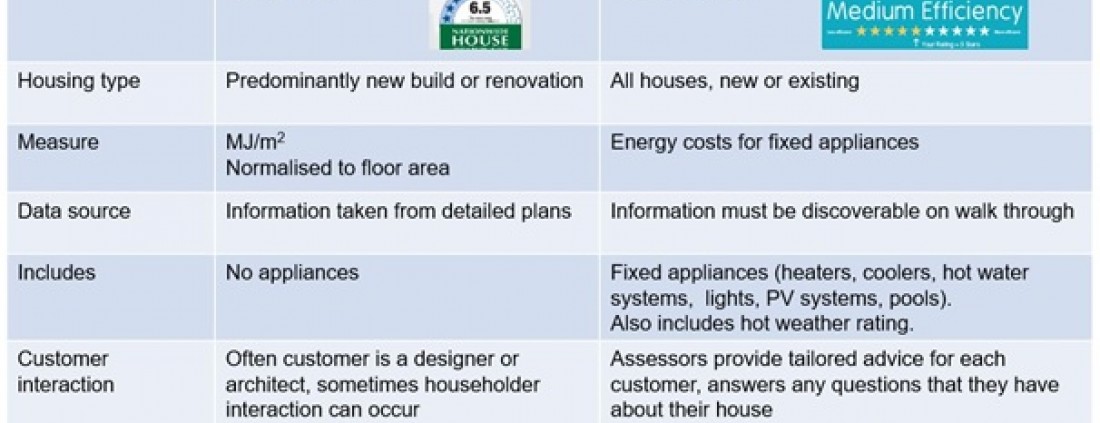
Maximising Value Using Residential Efficiency Scorecard
Danielle King | 24 Aug 2020
Things in the residential efficiency arena are finally changing for the better. Householders are realising the value of comfortable and highly efficient homes; banks are offering efficient home loan discounts and now the Residential Efficiency Scorecard is being incorporated into NatHERS providing a way to reliably rate existing homes. Here is my perspective on what GBI members and builders should know.
BACKGROUND:
For over a decade there has been talk of introducing disclosure of residential property energy efficiency at the point of sale or rent. Apart from being implemented in the ACT (using the now unsupported First Rate 4) in 2004, disclosure for existing homes elsewhere sadly never progressed, partially due an appropriate tool not being available.
Using the existing NatHERS suite of tools to rate existing homes for disclosure was investigated. However, the cost of having plans drawn up (for existing homes without them) to provide a rating using First Rate, Accurate or BersPro made it too much of a financial burden for the average householder. A cheaper solution needed to be found for existing homes.
The Residential Efficiency Scorecard (or Scorecard) was created for the purpose of rating existing homes in Victoria. Initially for disclosure, but it can be used for so much more. Furthermore, its capability to become a national tool has now been trialled and proven, and in July 2020 it was announced that Scorecard would become part of the NatHERS suite of tools to provide ratings for existing homes.
The Scorecard provides a government backed, trusted tool to measure and quantify the energy efficiency of a home to fill that gap. This is significant because it creates new opportunities for existing residential efficiency assessors, builders, designers and thermal performance assessors to expand services and further improve the housing stock they are working with. It is also likely to be used to inform future policies and provide a tool for disclosure purposes when that becomes a requirement.
ABOUT SCORECARD:
The Residential Efficiency Scorecard was designed to help households better understand the energy performance of their homes by allocating a rating between 1 and 10 stars. The star rating covers both the building shell and fixed appliances and is based on cost to run. So, a 1 star rated home would be expensive to run, and a 10 star home would be very cost efficient to run.
The Scorecard certificate also shows:
- The star rating out of 10 with and without solar PV
- How your fixed household appliances (such as heating systems, air conditioners, lighting, hot water, pools and spas) compare to the best-in-class
- How much energy is covered by solar PV, if you have it
- Ways to improve the energy efficiency of your home
- The home’s hot and cold weather rating (whether it will stay comfortable during those seasons without using significant active heating or cooling).
Assessments can be performed on existing houses and off the plan. Apartments can also be assessed if the property has its own heating, cooling, hot water and other services.
The recommendations on the certificate are generated by calculations based on the current features and equipment in the home. Certificate recommendations are impartial and tend to be general, and it is the role of the assessor to talk through the priorities of any recommendations taking into account the specific needs of the situation.
A Scorecard rating represents the performance of the home at the point the assessor undertook the rating. If the home is upgraded or renovated the initial certificate will no longer be valid. The assessor can update the existing rating, or create a new rating, depending on the requirements.
What can it be used for?
- Showcasing the efficiency of a home you have designed and/or built
- Identifying the level of efficiency of an existing home
- Identifying how to improve the cost efficiency of the home
- Quantifying improvements of renovation and appliance upgrades (ie if x is upgraded the impact on the rating is y)
- Comparing one home with another (in terms of cost efficiency to run) for buying, selling or renting
- Obtaining discounts on home loans (currently via Bank Australia)
- Potentially qualifying for Environmental Upgrade Finance via councils (coming soon)
- Demonstrate home value (see notes under Valuing Efficiency later in this article)
A key benefit is that for customers whose homes have obtained a high Scorecard rating, not only will they be proud of a highly rated home, they would also realise the value of a house that is low cost to run, and likely to gain higher market prices when they come to sell in the future.
The price of assessments is set by the market and ranges from $250 to $500. The actual cost will depend on the size of the home, location and the complexity of the assessment. Scorecard assessments are delivered by government accredited assessors. There are also Scorecard Accredited assessors in the major capital cities around Australia.
If you need to confirm the validity of a Scorecard rating check the address on the certificate matches the address of the home, look at the date of assessment to check currency, and that the assessor name and identifying accreditation number is listed. If you are still concerned or would like further information contact the Scorecard Assessor or the Scorecard Team
Thermal Performance Assessors would find it relatively simple to add Scorecard Assessments to their services as they already have the building shell knowledge. As long as they can demonstrate solid knowledge in the key energy efficient appliances, the training and exam is likely to be a straightforward process. Accreditation requirements for Scorecard Assessors can be found here. https://www.victorianenergysaver.vic.gov.au/save-energy-and-money/get-a-home-energy-assessment/deliver-assessments
Builders, building designers and architects already know there is a strong business case for energy efficient homes. Now there is a reliable way to communicate the cost efficiency of a home, using Scorecard.
The difference between Scorecard and the NatHERS rating system
Currently the best-known tool for rating homes is the Nationwide House Energy Rating Scheme (NatHERS). Like Scorecard, NatHERS uses a star rating from 1 to 10.
NatHERS predominately rates the building shell, its unit of measurement is MJ/m2 and can be used for building compliance. Scorecard rates the building shell and key fixed appliances based on cost to run. It is not currently used as a tool to demonstrate compliance but that may change in the future.
The key differences between NatHERS and Scorecard are in the table below:

Both tools treat the building shell similarly and the Scorecard will soon take NatHERS ratings as an input field. The Scorecard has been correlated against NatHERS to confirm the two tools are consistent. A home with a good NatHERS building shell rating should also rate well under the Scorecard building shell elements.
About the National Scorecard Pilot
As notified in the Scorecard Update: Bulletin #21 - A national version of the Victorian Residential Efficiency Scorecard Program (the Scorecard) will be incorporated into the Nationwide House Energy Rating Scheme (NatHERS), so that NatHERS can provide energy ratings for existing homes.
This will require further work and consultation with key stakeholders to establish the NatHERS requirements for existing homes, followed by refinements being made to the Scorecard to ensure it fulfils these requirements and is fit for purpose for potential programs.
A Scoping Report found the option to extend NatHERS to existing homes, while continuing to test and learn from the Scorecard, is the most efficient and effective use of resources. A transition to an open market will follow, where other energy rating tools for existing homes can seek NatHERS accreditation.
This approach ensures an early delivery of ratings and tools to support market-driven initiatives that encourage improved energy efficiency in existing homes, while also not locking in a single approach. For more information please see the Scoping Report: Extension of NatHERS to existing homes
Scorecard program was piloted nationally in 2018 and 2019 under the National Energy Productivity Plan (NEPP) measure 5. The pilot was conducted in all capital cities and in three tropical locations.
Scorecard was tested in a range of houses and covered:
- training and accreditation process,
- feedback from participants,
- comparison with the SA Retailer Energy Efficiency Scheme (REES) audit,
- comparison with FirstRate4 outputs,
- off plan data entry,
- targeted industry pilot, and
- use in the real-estate sector at the point of sale.
The Scorecard Team had 14 Scorecard assessors conduct 137 assessment in the major cities and 31 in tropical climates. We learned that:
- the accreditation process was suitable for assessors outside of Victoria
- Scorecard can be successfully used in various climates and house types
- additional reporting requirements are necessary for different stakeholder groups (e.g. community housing) and
- assessor and customer feedback were very complimentary on the benefits of the program.
To see the full reports please go to: https://www.energy.gov.au/publications/reports-national-pilots-residential-efficiency-scorecard
How Scorecard can benefit your business and clients
- Additional service for assessors/designers – provide a Scorecard rating with the plans
- Guiding and quantifying upgrades for renovations and key appliance selection
- Can assist with finance – Environmental Upgrade Finance or discounted bank loan applications
- Rating can be promoted in the future to sell/rent the property
- Increases market value
Valuing Efficiency
There have been several pieces of research conducted over the past 10-15 years on the affect of energy efficiency and sustainability on both residential and commercial property market prices. It is now well known in the commercial sector that high NABERS or Green Star rating can increase the property value from between 3% to 22% depending on the property and location. Similarly, in the residential sector, market value has shown to increase if the home has energy efficiency features or a high star rating from a reputable source.
The first piece of research in Australia was conducted in Canberra after the ACT bought in mandatory disclosure for residential properties. The ACT Energy Efficiency Rating and House Price Report 2005 produced by independent researchers, found that at the point of sale or rent the market value increased by between 3-5% for each star above the norm that the property had.
PRD Nationwide have also researched the economic benefit in conjunction with the Queensland University of Technology (funded by the Australian Research Council) which found evidence that people will pay a premium for well-designed efficient homes of 10% and higher depending on the home and location. Such homes also sold faster.
Internationally, studies have shown in the UK house market price increases of between 5-20% for homes that rate well (A or B grade) on their Energy Performance Certificate rating scheme. Again, depending on home and location results vary but increases were noted in all areas analysed. Even the USA (UNC Environmental Finance Centre) have identified price premiums of high-performance homes of between 3 and 10% and on average these homes sold 10-30% faster.
And what about demand? In Western Australia Curtin University Sustainability Policy Institute (CUSP), Chiara Pacifici conducted some housing research on this topic. She produced the ‘What Perth Wants’ report and found that 89% of respondents would like to see ‘more eco-friendly buildings that generate their own power, collect rainwater and use less energy’. There is clearly an appetite for efficient housing.
In short there is demand, there is value and now there is a way to communicate in a trusted and simple to understand manner.
Finally, it's worth noting that efficient homes are not a fad, or a temporary trend; they are the future of real estate and tomorrows market. Having a trusted mechanism to rate and promote such homes is key to recognising their true value. Both NatHERS and Scorecard can now be used to demonstrate and promote a highly efficient home.
Scorecard case studies:
https://www.victorianenergysaver.vic.gov.au/save-energy-and-money/get-a-home-energy-assessment/getting-an-assessment/if-youre-building-a-new-home
https://www.victorianenergysaver.vic.gov.au/save-energy-and-money/get-a-home-energy-assessment/getting-an-assessment/if-youre-renovating
https://www.victorianenergysaver.vic.gov.au/save-energy-and-money/get-a-home-energy-assessment/getting-an-assessment/if-youre-spending-too-much-on-energy
AUTHOR:
Danielle King
Director, Sustainability Advisor, Educator; Green Moves Aust, Manager of Green Property Professionals Program, Green Building Institute